Modeling of Gas Migration in Large Elevation Difference Oil Transmission Pipelines during the Commissioning Process
Abstract
:1. Introduction
2. The Gas-to-Liquid Replacement Model
2.1. The Gas-to-Liquid Replacement and Two-Phase Flow Processes
2.2. Modeling the Gas–Liquid Two-Phase Flow
2.2.1. The Formation of Gas Accumulation Section
2.2.2. Compression Model of the Gas Accumulation Section
3. Analysis of Gas Migration in Different Pipeline Topographies
3.1. Division of Different Pipeline Terrains
3.2. The Hydraulic Air Vent Model of a Continuous Undulating Pipeline
4. Calculation of Gas-Phase Migration in a Continuous Undulating Pipeline
- (1)
- The hydraulic air vent speed is affected by the backpressure. For the same pipe length, the larger the upwards inclination angle, the faster the gas bubble breakage and the larger the hydraulic air vent volume.
- (2)
- The multi-pipe hydraulic air vent process is more complicated than that of a single pipe and is affected by gas mass transfer and backpressure transfer. In comparison with the single-pipe flow, the multi-pipe flow is more dangerous due to backpressure fluctuations, the faster hydraulic air vent speed, and the higher air pressure.
- (3)
- The mass transfer of the gas section is one of the reasons for the overpressure at some points of the pipeline. The gas section at the point with the highest backpressure is more likely to be completely broken, and the broken bubbles will be transmitted downstream of the pipe, forming a new gas section in a new pipe section with a lower backpressure that may even exceed the length of the original gas section.
- (4)
- In pipe sections with a low backpressure, and pipe sections with large differences in the backpressure between the front and back of the sections, special attention should be paid to preventing pressure overrun, and gas should be timely vented to prevent air resistance at high points.
- (5)
- In addition to high points, temporary air vent valves should be installed at some locations where the terrain is undulating and where it is difficult to establish the backpressure. Alternatively, it is necessary to control the flow rate and to vent the air during the commissioning process.
5. Conclusions
- (1)
- The presence of gas migration in the continuous section will seriously affect the state of gas storage in the pipeline, resulting in abnormal pressure.
- (2)
- Considering the mutual influence of the gas-phase transfer between each pipe section in large elevation difference oil transmission pipelines, and the effect of the length, inclination, and backpressure of each pipe section on the air vent process, the gas-phase migration model established in this paper is suitable for a commissioning process of continuous undulating large-drop liquid pipelines, as it can accurately predict the gas accumulation and pipe section pressure of each U-shaped unit.
- (3)
- The model results were compared with the on-site production data of a domestic crude oil pipeline. The results demonstrate that the maximum deviation between the calculated pressure during the start-up process and real data is 0.3 MPa, indicating that the model can provide theoretical guidance and technical support for the safe and stable operation of continuous undulating liquid pipelines with large drops, in the future.
- (4)
- In the simulation process, the controlled variable method was used, which mainly considers the influence of the terrain itself on the hydraulic air vent but ignores some other parameters. In future research, more consideration should be given to the properties of the pipe and the liquid, such as the pipe diameter, and liquid density and viscosity, which will contribute to a broader application range of the model. Additionally, more experimental results will be useful to verify and improve the model.
Author Contributions
Funding
Institutional Review Board Statement
Informed Consent Statement
Data Availability Statement
Conflicts of Interest
References
- Jia, W.; Zhang, Y.; Li, C.; Luo, P.; Song, X.; Wang, Y.; Hu, X. Experimental and numerical simulation of erosion-corrosion of 90° steel elbow in shale gas pipeline. J. Nat. Gas Sci. Eng. 2021, 89, 103871. [Google Scholar] [CrossRef]
- Romero, G.; Fuertes-Miquel, V.S.; Coronado-Hernández, Ó.E.; Ponz-Carcelén, R.; Biel-Sanchis, F. Transient Phenomena Generated in Emptying Operations in Large-Scale Hydraulic Pipelines. Water 2020, 12, 2313. [Google Scholar] [CrossRef]
- Gong, J.; Yan, D.F. Analysis of flow characteristics for slack line flow in a long slope pipeline. J. China Univ. Pet. (Ed. Nat. Sci.) 1995, 19, 65–72. [Google Scholar]
- Gong, J.; Yan, D.F. Transient analysis for slack line flow in a long slope pipeline. J. Fushun Pet. Inst. 1996, 16, 45–50. [Google Scholar]
- Chen, Q.X.; Sang, G.S. Some technical problems about high elevation pipeline. Oil Gas Storage Transp. 1998, 17, 11–13. [Google Scholar]
- Jia, W.; Ban, J.; Liang, F.; Cheng, T.; He, Y.; Li, C. A New Homogeneous Non-Equilibrium Model to Compute Vapor-Liquid Two-Phase Critical Pressure Ratios of Multicomponent Hydrocarbon Mixtures. J. Loss Prev. Process Ind. 2020, 68, 104338. [Google Scholar] [CrossRef]
- Jepson, W.P. The flow characteristics in horizontal slug flow. In Proceedings of the 3rd International Conference on Multiphase Flow, The Hague, The Netherlands, 18–20 May 1987; pp. 187–198. [Google Scholar]
- Livinus, A.; Verdin, P.G. Experimental study of a single elongated bubble in liquid in under 10-degree upwardly inclined pipes. Exp. Therm. Fluid Sci. 2021, 120, 110247. [Google Scholar] [CrossRef]
- Wu, L.-Y.; Liu, L.-B.; Han, X.-T.; Li, Q.-W.; Yang, W.-B. Numerical simulation on dynamic behaviors of bubbles flowing through bifurcate T-junction in microfluidic device. Chin. Phys. B 2019, 28, 104702. [Google Scholar] [CrossRef]
- Fernandes, R.C.; Semiat, R.; Dukler, A.E. Hydrodynamic model for gas-liquid slug flow in vertical tubes. AIChE J. 1983, 29, 981–989. [Google Scholar] [CrossRef]
- Fan, Z.; Lusseyran, F.; Hanratty, T.J. Initiation of slugs in horizontal gas-liquid flows. AIChE J. 1993, 39, 1741–1753. [Google Scholar] [CrossRef]
- Bonetto, F.; Lahey, R.T. An experimental study on air carry under due to a plunging jet. Int. J. Multiph. Flow 1993, 19, 281–294. [Google Scholar] [CrossRef]
- Manolis, I.G. High Pressure Gas-Liquid Slug Flow. Ph.D. Thesis, Imperial College London, London, UK, 1995. [Google Scholar]
- Grotjahn, K.; Mewes, D. Measurements and calculations on the transient behaviour of two-phase slug flow in a horizontal pipe. In Proceedings of the Fourth International Conference on Multiphase Flow, New Orleans, LA, USA, 27 May–1 June 2001. [Google Scholar]
- Andreussi, P.; Bendiksen, K. An investigation of void fraction in liquid slugs for horizontal and inclined gas—Liquid pipe flow. Int. J. Multiph. Flow 1989, 15, 937–946. [Google Scholar] [CrossRef]
- Bendiksen, K.H.; Malnes, D.; Nydal, O.J. On the modeling of slug flow. Chem. Eng. Commun. 1996, 141–142, 71–102. [Google Scholar] [CrossRef]
- Lu, J.; Wang, T.; Li, L.; Yin, Z.; Wang, R.; Fan, X.; Tan, D. Dynamic Characteristics and Wall Effects of Bubble Bursting in Gas-Liquid-Solid Three-Phase Particle Flow. Processes 2020, 8, 760. [Google Scholar] [CrossRef]
- Bacon, R.P.; Scott, D.M.; Thorpe, R.B. Large bubbles attached to spargers in downwards two-phase flow. Int. J. Multiph. Flow 1995, 21, 949–959. [Google Scholar] [CrossRef]
- Nydal, O.J.; Banerjee, S. Dynamic slug tracking simulations for gas-liquid flow in pipelines. Chem. Eng. Commun. 1996, 141–142, 13–39. [Google Scholar] [CrossRef]
- Brauner, N.; Ullmann, A. Modelling of gas entrainment from Taylor bubbles. Part A: Slug flow. Int. J. Multiph. Flow 2004, 30, 239–272. [Google Scholar] [CrossRef]
- Zhang, N.; Gong, J.; Min, X.H.; Gao, F.L.; Chen, S.D.; Li, X.P. The influence of elevation on the commissioning of China West products pipeline. Oil Gas Storage Transp. 2008, 27, 5–8. [Google Scholar]
- Zhang, X.Y. Study on the Hydraulic Characteristics of Oil Pipeline Direct Commissioning Process. Master’s Thesis, China University of Petroleum, Beijing, China, 2015. [Google Scholar]
- Chen, S.; Gong, J.; Li, W.; Yang, Q.; Shi, G.; Li, X.; Shi, B.; Song, S.; Lv, P.; Fan, D.; et al. A new transient model of multi-scale bubble migration and evolution during gas-liquid flow in pipelines. J. Pet. Sci. Eng. 2021, 205, 108888. [Google Scholar] [CrossRef]
- Zeng, Y.; Xu, W. Investigation on Bubble Diameter Distribution in Upward Flow by the Two-Fluid and Multi-Fluid Models. Energies 2021, 14, 5776. [Google Scholar] [CrossRef]
- Chen, Y.Y. Study on Air Entrainment in Downhill Section of Large Slope Pipeline. Master’s Thesis, China University of Petroleum, Beijing, China, 2014; pp. 70–77. [Google Scholar]
- Chen, Y.Y.; Gong, J.; Yu, D.; Wu, H.H.; Li, X.P.; Gao, B.X. Development of slack flow analysis software for large-slope pipeline. Oil-Gas Field Surf. Eng. 2013, 32, 1–2. [Google Scholar]
- Rosero, C.M.P.; Celis, G.E.O.; Loureiro, J.B.R.; Silva Freire, A.P. Phenomenology of bubble breakup and coalescence in sudden expansions and contractions in vertical pipes. Int. J. Multiph. Flow 2022, 146, 103840. [Google Scholar] [CrossRef]
- Rodrigues, R.L.P.; Bertoldi, D.; dos Santos, E.N.; Schneider, F.A.; Neto, M.A.M.; da Silva, M.J.; Morales, R.E.M. Experimental analysis of downward liquid-gas slug flow in slightly inclined pipes. Exp. Therm. Fluid Sci. 2019, 103, 222–233. [Google Scholar] [CrossRef]
- Jia, W.; Yang, F.; Li, C.; Huang, T.; Song, S. A unified thermodynamic framework to compute the hydrate formation conditions of acidic gas/water/alcohol/electrolyte mixtures up to 186.2 MPa. Energy 2021, 230, 120735. [Google Scholar] [CrossRef]
- Chen, W.; Xu, H.-L.; Kong, W.-Y.; Yang, F.-Q. Study on three-phase flow characteristics of natural gas hydrate pipeline transmission. Ocean Eng. 2020, 214, 107727. [Google Scholar] [CrossRef]
- Zhang, N. Study on Two Phase Flow Law of Liquid Gas Replacement Process in Undulating Pipeline. Ph.D. Thesis, China University of Petroleum, Beijing, China, 2009. [Google Scholar]
- Wang, K.X.; Wang, Y.; Ma, J. Transient numerical simulation of gas-liquid two-phase flow in long distance water supply pipeline. In Proceedings of the 4th International Workshop on Renewable Energy and Development (IWRED), Sanya, China, 24–26 April 2020. [Google Scholar]
- Jia, W.; Okuno, R. Modeling of asphaltene and water associations in petroleum reservoir fluids using cubic-plus-association EOS. AIChE J. 2018, 64, 3429–3442. [Google Scholar] [CrossRef]
- Masiukiewicz, M.; Anweiler, S. Precise Evaluation of Gas–Liquid Two-Phase Flow Pattern in a Narrow Rectangular Channel with Stereology Method. Energies 2021, 14, 3180. [Google Scholar] [CrossRef]
- Huang, Y.; Yang, J.; Meng, L.; Chen, X.; Luo, M.; Li, W. Numerical Investigation on Gas Accumulation and Gas Migration in the Wavy Horizontal Sections of Horizontal Gas Wells. Math. Probl. Eng. 2020, 2020, 7275209. [Google Scholar] [CrossRef]
- Taitel, Y.; Dukler, D. Two phase slug flow. Adv. Heat Transf. 1990, 20, 83–132. [Google Scholar]
- Shoham, O.; Taitel, Y. Stratified turbulent-turbulent gas-liquid flow in horizontal and inclined pipes. AIChE J. 1984, 30, 377–385. [Google Scholar] [CrossRef]
- Zhang, D.; Zhang, H.; Rui, J.; Pan, Y.; Liu, X.; Shang, Z. Prediction model for the transition between oil–water two-phase separation and dispersed flows in horizontal and inclined pipes. J. Pet. Sci. Eng. 2020, 192, 107161. [Google Scholar] [CrossRef]
- Jia, W.; Lin, Y.; Yang, F.; Li, C. A novel lift-off diameter model for boiling bubbles in natural gas liquids transmission pipelines. Energy Rep. 2020, 6, 478–489. [Google Scholar] [CrossRef]
- Liu, E.; Guo, B.; Wang, M.; Ma, X.; Peng, Y. Analysis of the water-filling process for crude oil pipelines with a large drop in height. Energy Sci. Eng. 2020, 8, 2100–2115. [Google Scholar] [CrossRef]
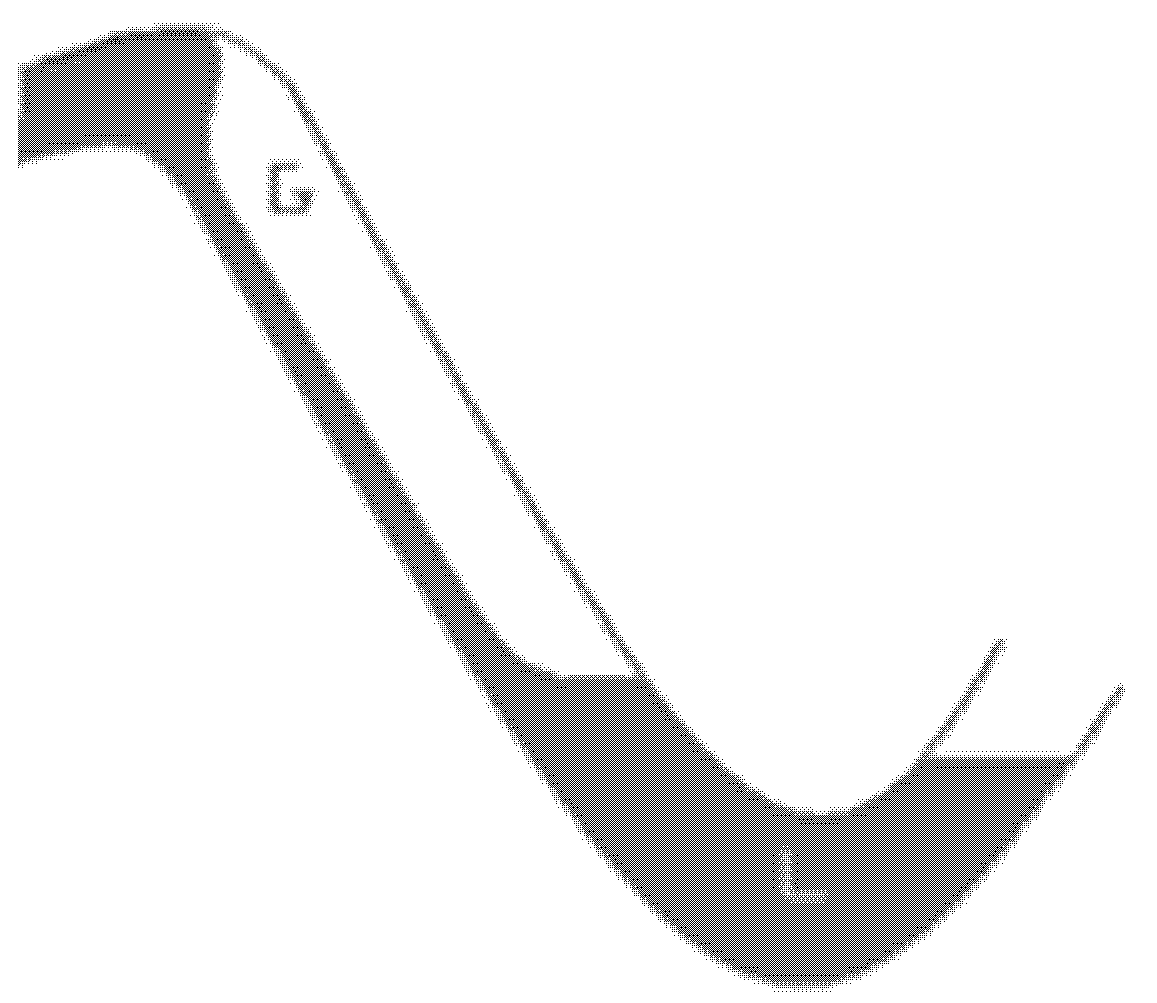


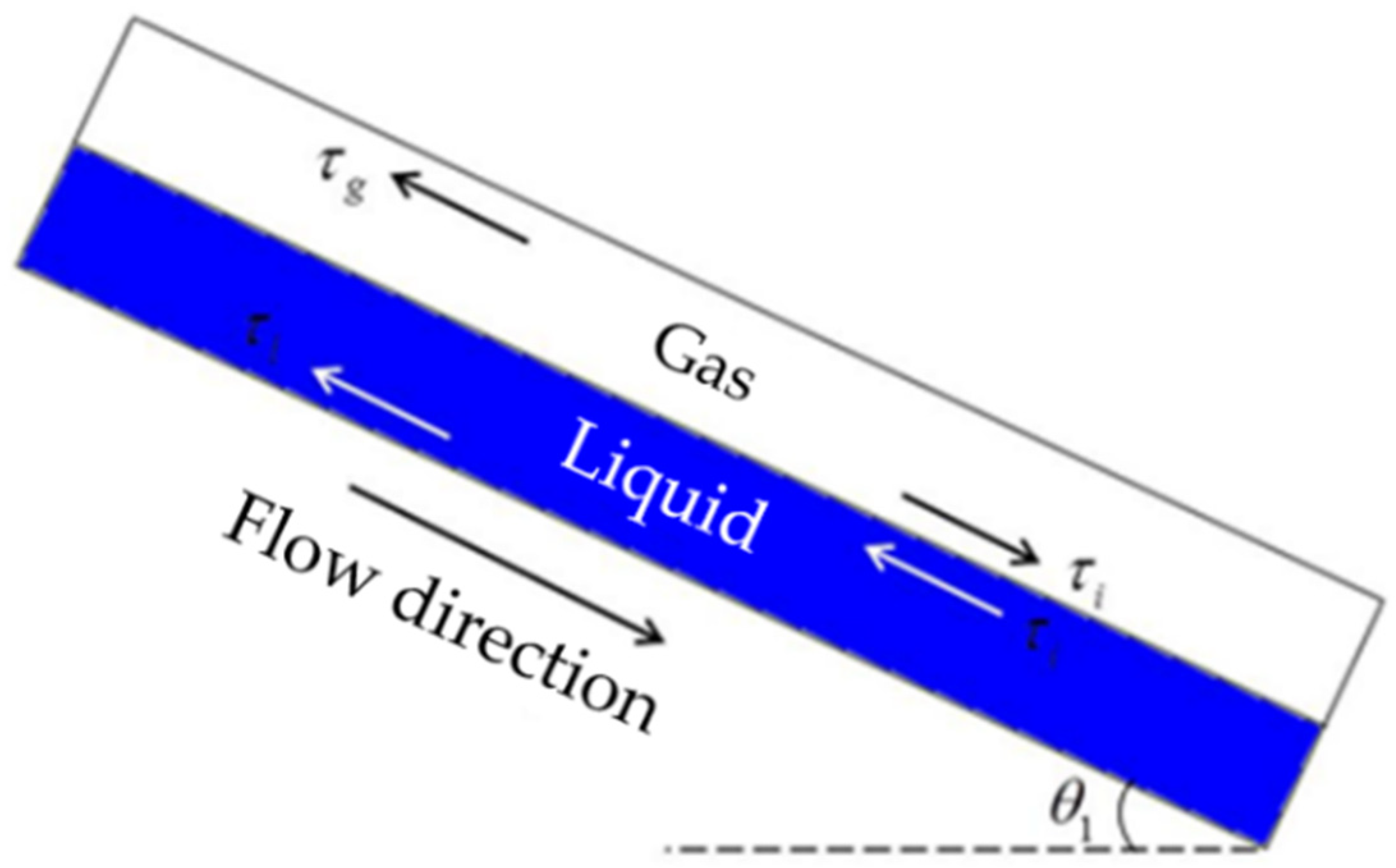

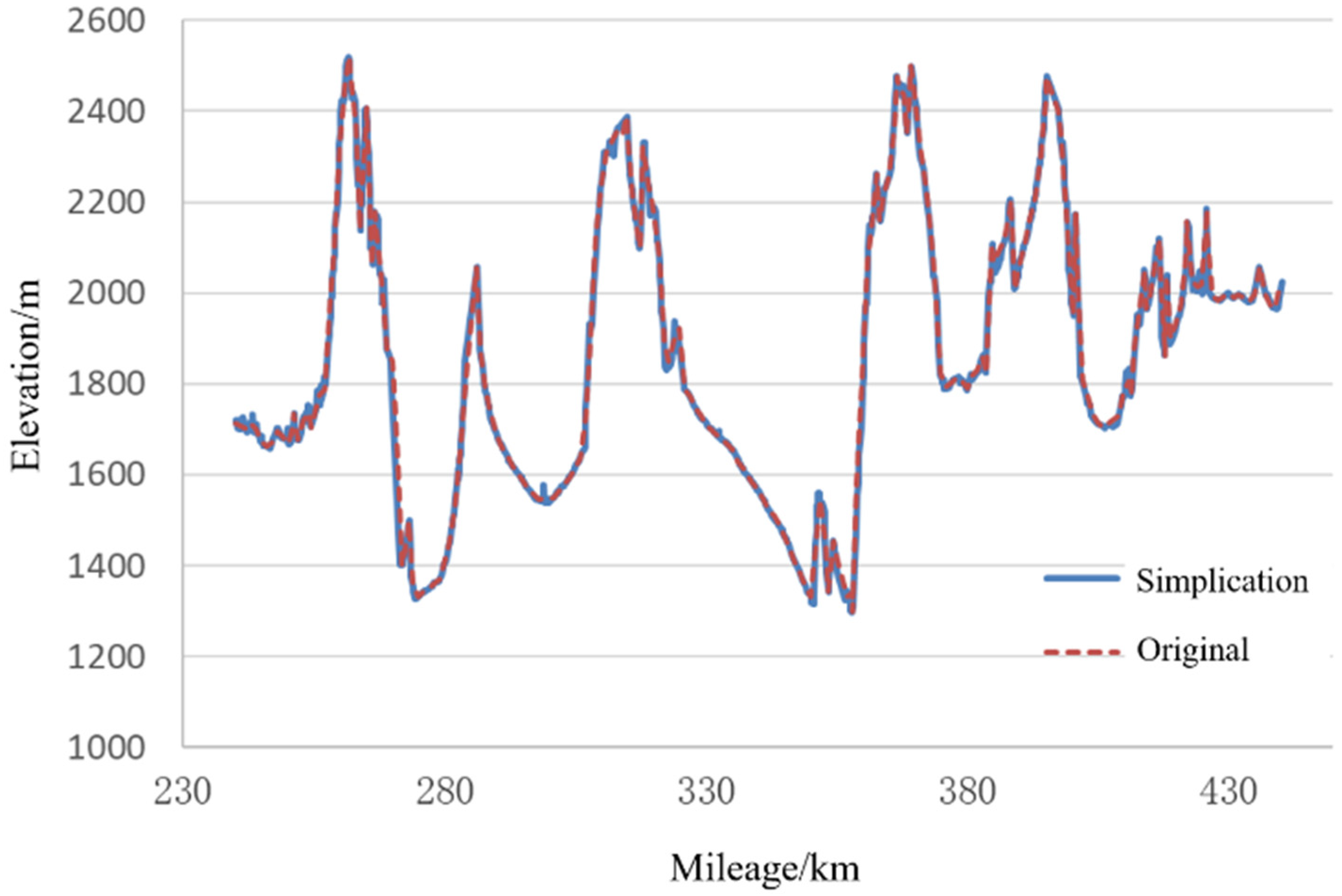

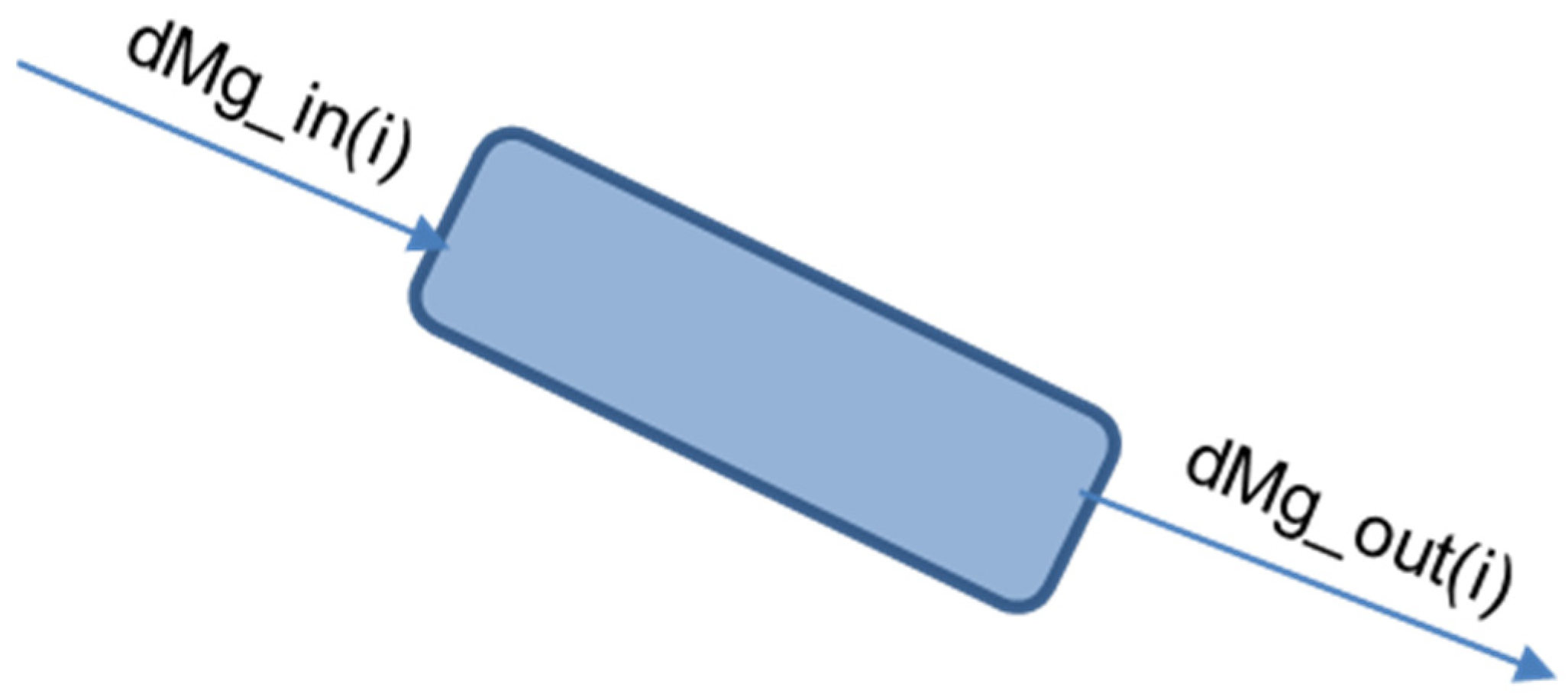
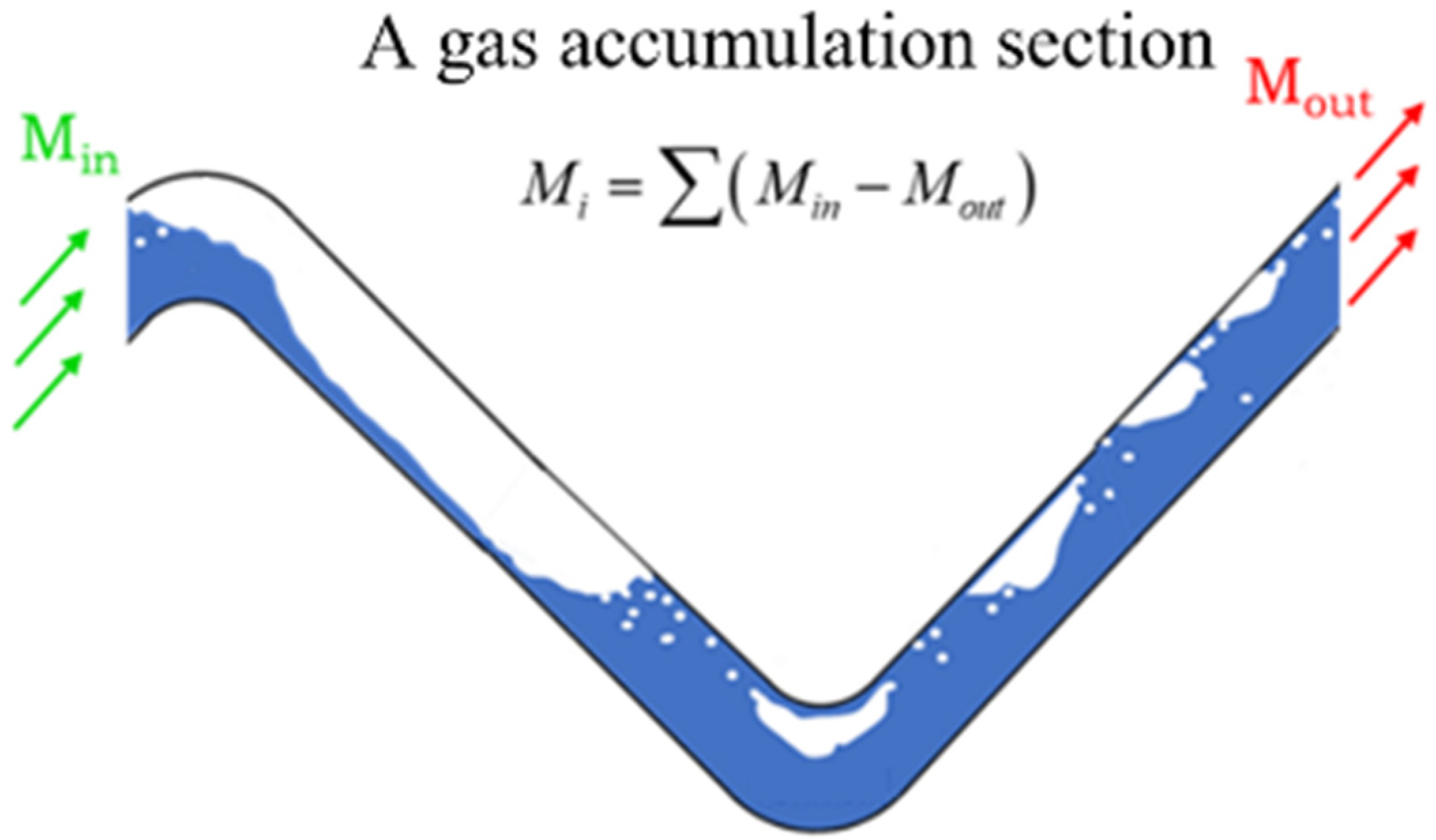
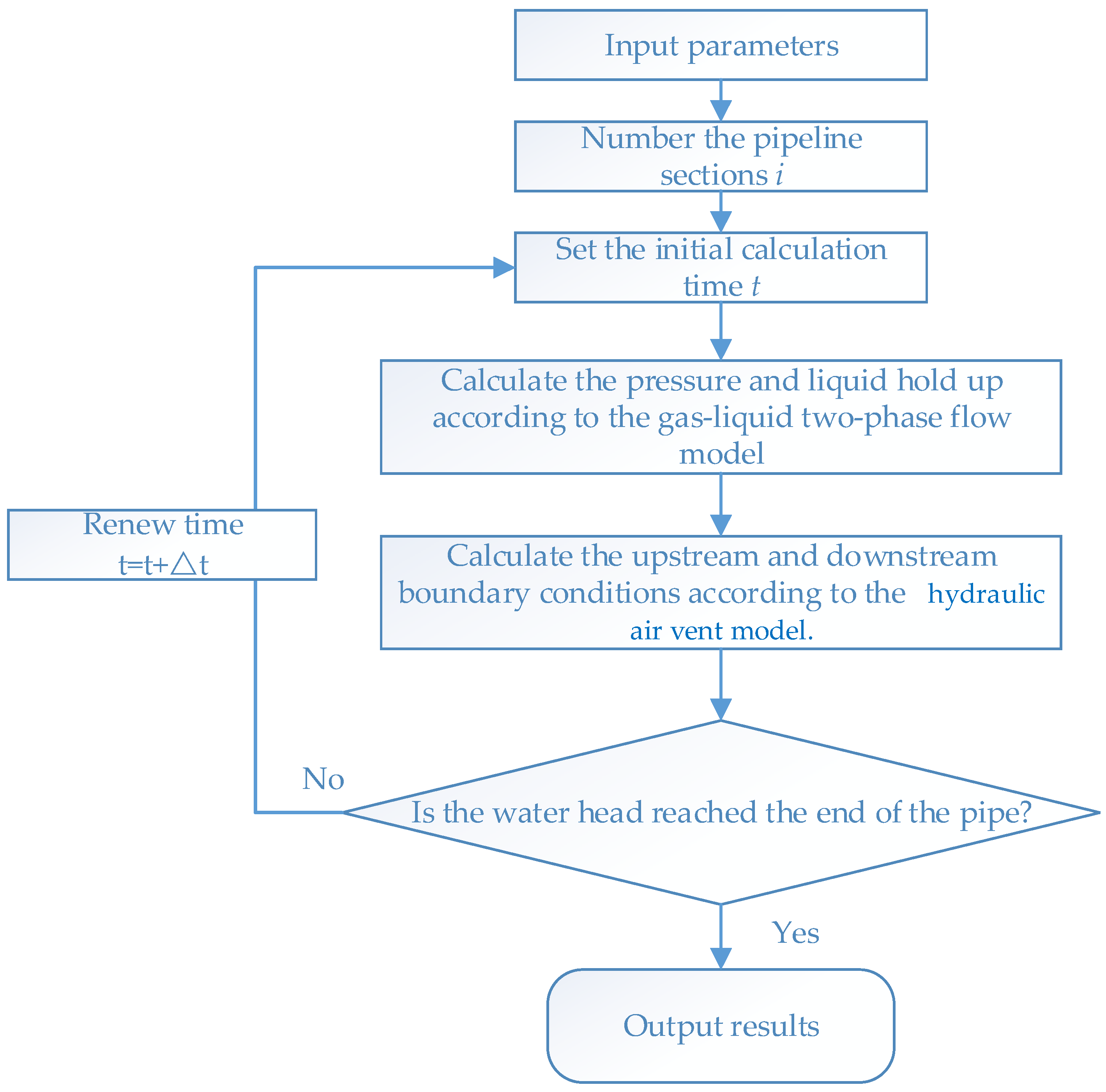
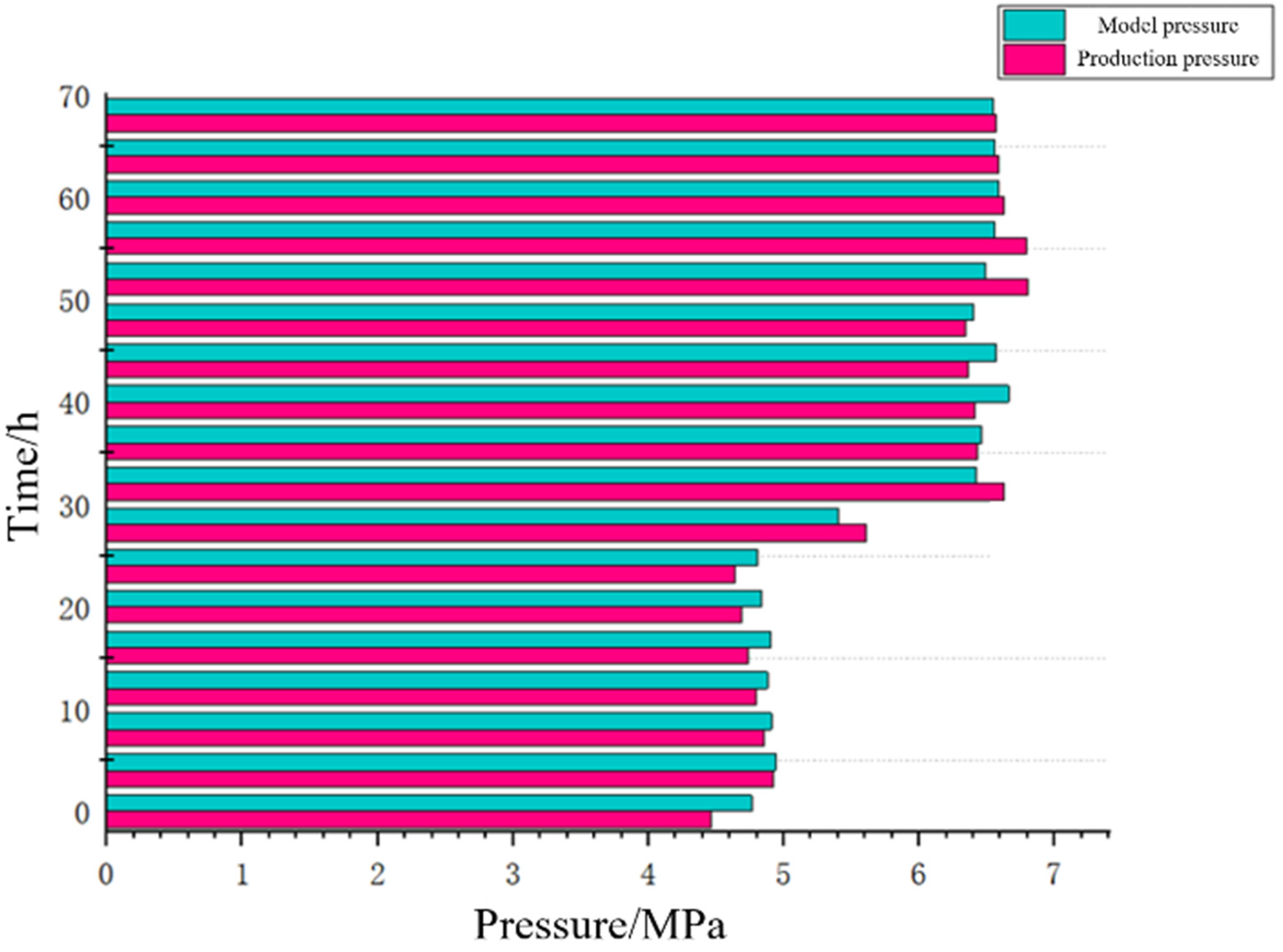

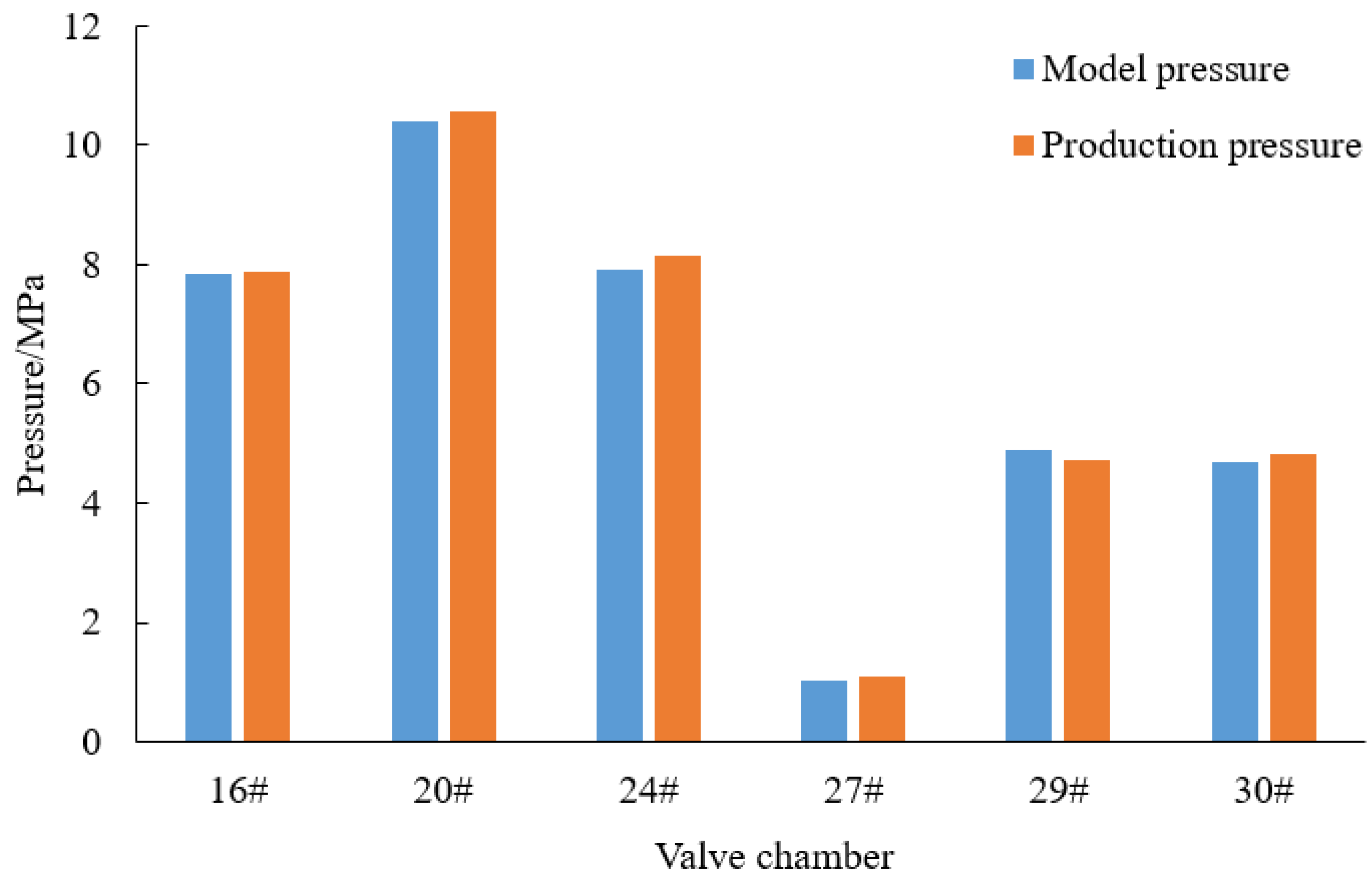
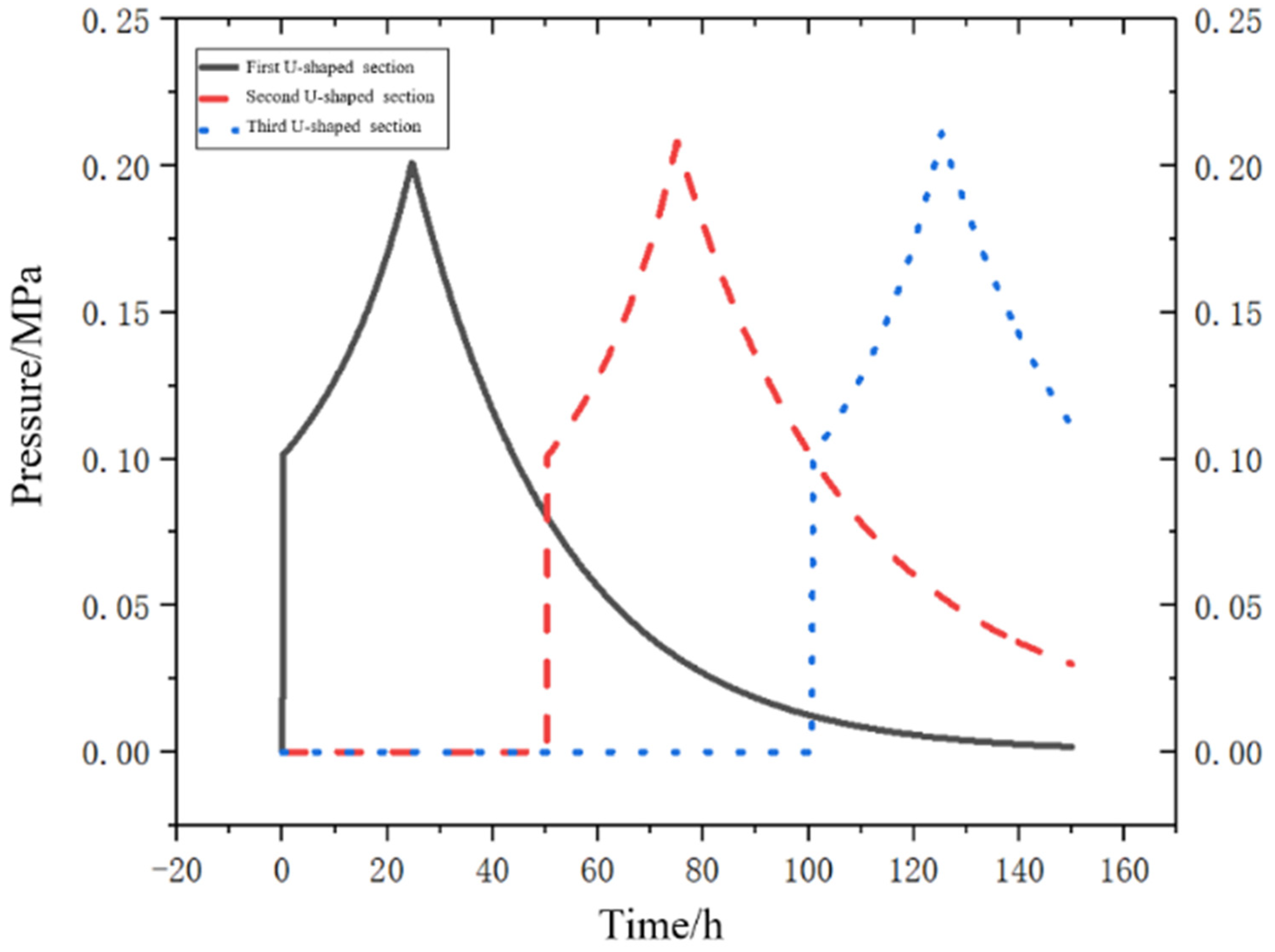


| Type | Inlet Conditions | Gas in Pipe | Gas Migration |
|---|---|---|---|
| Gas–liquid two-phase flow in commissioning | Liquid phase only | Atmospheric air | The gas section is sealed at a high point and can be transported after meeting certain conditions |
| Traditional gas–liquid two-phase flow | Gas–liquid two-phase | Injected gas into the inlet | The gas and liquid move at the same time or have a speed difference |
| Angle φ | Radian | Slope (‰) |
|---|---|---|
| 0.25 | 0.0044 | 4.36 |
| 0.5 | 0.0087 | 8.73 |
| 0.75 | 0.0131 | 13.09 |
| 1 | 0.0175 | 17.46 |
| 1.25 | 0.0218 | 21.82 |
| 1.5 | 0.0262 | 26.19 |
| 1.75 | 0.0305 | 30.55 |
| 2 | 0.0349 | 34.92 |
| 2.25 | 0.0393 | 39.29 |
| 2.5 | 0.0436 | 43.66 |
| Pump Station | Mileage (km) | Elevation (m) |
|---|---|---|
| #1 | 0 | 735 |
| #2 | 106.8 | 883 |
| #3 | 153.3 | 1854 |
| #4 | 248.1 | 1688 |
| #5 | 402.4 | 1770 |
| Valve Chamber | Mileage (km) | Elevation (m) |
|---|---|---|
| #16 | 269.9 | 1861 |
| #20 | 353.0 | 1451 |
| #24 | 411.1 | 1832 |
| #27 | 480.6 | 2401 |
| #29 | 533.1 | 1832 |
| #30 | 548.1 | 1799 |
Publisher’s Note: MDPI stays neutral with regard to jurisdictional claims in published maps and institutional affiliations. |
© 2022 by the authors. Licensee MDPI, Basel, Switzerland. This article is an open access article distributed under the terms and conditions of the Creative Commons Attribution (CC BY) license (https://creativecommons.org/licenses/by/4.0/).
Share and Cite
Feng, L.; Zhu, H.; Song, Y.; Cao, W.; Li, Z.; Jia, W. Modeling of Gas Migration in Large Elevation Difference Oil Transmission Pipelines during the Commissioning Process. Energies 2022, 15, 1379. https://doi.org/10.3390/en15041379
Feng L, Zhu H, Song Y, Cao W, Li Z, Jia W. Modeling of Gas Migration in Large Elevation Difference Oil Transmission Pipelines during the Commissioning Process. Energies. 2022; 15(4):1379. https://doi.org/10.3390/en15041379
Chicago/Turabian StyleFeng, Liang, Huafeng Zhu, Ying Song, Wenchen Cao, Ziyuan Li, and Wenlong Jia. 2022. "Modeling of Gas Migration in Large Elevation Difference Oil Transmission Pipelines during the Commissioning Process" Energies 15, no. 4: 1379. https://doi.org/10.3390/en15041379
APA StyleFeng, L., Zhu, H., Song, Y., Cao, W., Li, Z., & Jia, W. (2022). Modeling of Gas Migration in Large Elevation Difference Oil Transmission Pipelines during the Commissioning Process. Energies, 15(4), 1379. https://doi.org/10.3390/en15041379






